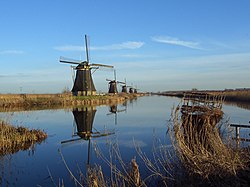Waterlogging (agriculture)
This article needs additional citations for verification. (March 2017) |


Waterlogging is the saturation of soil with water.[1] Soil may be regarded as waterlogged when it is nearly saturated with water much of the time such that its air phase is restricted and anaerobic conditions prevail. In extreme cases of prolonged waterlogging, anaerobiosis occurs, the roots of mesophytes suffer, and the subsurface reducing atmosphere leads to such processes as denitrification, methanogenesis, and the reduction of iron and manganese oxides.[2]
All plants, including crops require air (specifically, oxygen) to respire, produce energy and keep their cells alive. In agriculture, waterlogging of the soil typically blocks air from getting in to the roots.[3] With the exception of rice (Oryza sativa),[4][5] most crops like maize and potato,[6][7][8] are therefore highly intolerant to waterlogging. Plant cells use a variety of signals such the oxygen concentration,[9] plant hormones like ethylene,[10][11] energy and sugar status[12][13] to acclimate to waterlogging-induced oxygen deprivation.
In irrigated agricultural land, waterlogging is often accompanied by soil salinity as waterlogged soils prevent leaching of the salts imported by the irrigation water.
From a gardening point of view, waterlogging is the process whereby the soil hardens to the point where neither air nor water can soak through.
See also[]
- Drainage
- Drainage research
- Drainage system (agriculture)
- Effects of weather on sport
- Environmental impact of irrigation
- Polder
- Soil salinity control
- Swamp
- Watertable control
References[]
- ^ "waterlog - definition of waterlog in English | Oxford Dictionaries". Oxford Dictionaries | English. Retrieved 2017-03-10.
- ^ Hillel, Daniel (2004). Introduction to Environmental Soil Physics. United States of America: Elsevier Academic Press. pp. 441. ISBN 0-12-348655-6.
- ^ Sasidharan, Rashmi; Hartman, Sjon; Liu, Zeguang; Martopawiro, Shanice; Sajeev, Nikita; van Veen, Hans; Yeung, Elaine; Voesenek, Laurentius A. C. J. (February 2018). "Signal Dynamics and Interactions during Flooding Stress". Plant Physiology. 176 (2): 1106–1117. doi:10.1104/pp.17.01232.
- ^ Hattori, Yoko; Nagai, Keisuke; Furukawa, Shizuka; Song, Xian-Jun; Kawano, Ritsuko; Sakakibara, Hitoshi; Wu, Jianzhong; Matsumoto, Takashi; Yoshimura, Atsushi; Kitano, Hidemi; Matsuoka, Makoto; Mori, Hitoshi; Ashikari, Motoyuki (August 2009). "The ethylene response factors SNORKEL1 and SNORKEL2 allow rice to adapt to deep water". Nature. 460 (7258): 1026–1030. doi:10.1038/nature08258.
- ^ Xu, Kenong; Xu, Xia; Fukao, Takeshi; Canlas, Patrick; Maghirang-Rodriguez, Reycel; Heuer, Sigrid; Ismail, Abdelbagi M.; Bailey-Serres, Julia; Ronald, Pamela C.; Mackill, David J. (August 2006). "Sub1A is an ethylene-response-factor-like gene that confers submergence tolerance to rice". Nature. 442 (7103): 705–708. doi:10.1038/nature04920.
- ^ Sanclemente, Maria-Angelica; Ma, Fangfang; Liu, Peng; Della Porta, Adriana; Singh, Jugpreet; Wu, Shan; Colquhoun, Thomas; Johnson, Timothy; Guan, Jiahn-Chou; Koch, Karen E (15 March 2021). "Sugar modulation of anaerobic-response networks in maize root tips". Plant Physiology. 185 (2): 295–317. doi:10.1093/plphys/kiaa029.
- ^ Hartman, Sjon (15 March 2021). "Averting a sweet demise: sugars change the transcriptional hypoxia response in maize roots". Plant Physiology. 185 (2): 280–281. doi:10.1093/plphys/kiaa053.
- ^ Hartman, Sjon; van Dongen, Nienke; Renneberg, Dominique M.H.J.; Welschen-Evertman, Rob A.M.; Kociemba, Johanna; Sasidharan, Rashmi; Voesenek, Laurentius A.C.J. (13 August 2020). "Ethylene Differentially Modulates Hypoxia Responses and Tolerance across Solanum Species". Plants. 9 (8): 1022. doi:10.3390/plants9081022.
- ^ Gibbs, Daniel J.; Lee, Seung Cho; Md Isa, Nurulhikma; Gramuglia, Silvia; Fukao, Takeshi; Bassel, George W.; Correia, Cristina Sousa; Corbineau, Françoise; Theodoulou, Frederica L.; Bailey-Serres, Julia; Holdsworth, Michael J. (November 2011). "Homeostatic response to hypoxia is regulated by the N-end rule pathway in plants". Nature. 479 (7373): 415–418. doi:10.1038/nature10534.
- ^ Hartman, Sjon; Sasidharan, Rashmi; Voesenek, Laurentius A. C. J. (January 2021). "The role of ethylene in metabolic acclimations to low oxygen". New Phytologist. 229 (1): 64–70. doi:10.1111/nph.16378.
- ^ Liu, Zeguang; Hartman, Sjon; van Veen, Hans; Zhang, Hongtao; Leeggangers, Hendrika A.C.F.; Martopawiro, Shanice; Bosman, Femke; de Deugd, Florian; Su, Peng; Hummel, Maureen; Rankenberg, Tom; Hassall, Kirsty L.; Bailey-Serres, Julia; Theodoulou, Frederica L.; Voesenek, Laurentius A.C.J.; Sasidharan, Rashmi (23 January 2022). "Ethylene augments root hypoxia tolerance through amelioration of reactive oxygen species and growth cessation". bioRxiv. doi:10.1101/2022.01.21.477196.
- ^ Cho, Hsing‐Yi; Loreti, Elena; Shih, Ming‐Che; Perata, Pierdomenico (January 2021). "Energy and sugar signaling during hypoxia". New Phytologist. 229 (1): 57–63. doi:10.1111/nph.16326.
- ^ Schmidt, Romy R.; Fulda, Martin; Paul, Melanie V.; Anders, Max; Plum, Frederic; Weits, Daniel A.; Kosmacz, Monika; Larson, Tony R.; Graham, Ian A.; Beemster, Gerrit T. S.; Licausi, Francesco; Geigenberger, Peter; Schippers, Jos H.; van Dongen, Joost T. (18 December 2018). "Low-oxygen response is triggered by an ATP-dependent shift in oleoyl-CoA in Arabidopsis". Proceedings of the National Academy of Sciences. 115 (51): E12101–E12110. doi:10.1073/pnas.1809429115.
External links[]
- http://www.waterlog.info gives free downloads of software and articles on land drainage for waterlogging control.
- Irrigation
- Agricultural terminology
- Agriculture stubs